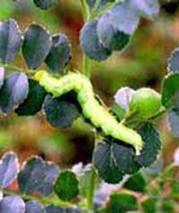Crop Protection : Pests of Bengal Gram
Semilooper : Autographa nigrisigna
Symptoms of damage
- Skeletinization of leaves and the plant becomes whitish
- The larvae feed on leaf buds, flowers, tender pods and developing seeds.
- Ragged and irregular pod. (This is in contrast with the neat, and round hole, characteristic of pod borer damage.)
Identification of the pest
- Moths have typically patterned forewings.
- The larva 25 mm long is green semiloopers.
|
 |
- ETL 10% affected parts
- Deep summer ploughing in 2-3 years to eliminate quiescent pupa.
- Early sowing, short duration varieties.
- Avoid closer plant spacing.
- Grow tall sorghum as comparison crop to serve as biological bird perches
- Collect and destroy larvae and adults to the extent possible
- Install pheromone traps at a distance of 50 m @ 5 traps/ha for each insect pest.
- Install Bird perches @ 50/ha.
- Setting of light traps (1 light trap/5 acre) to kill moth population.
- Control is achieved by releasing of Trichogramma chlionis at weekly intervals @1.5 lakh/ha/ week for four times.
- Conserve green lacewing, predatory stink bugs, spider, ants
- Application of NPV 250 LE /ha with teepol 0.1% and Jaggery 0.5% thrice at 10 – 15 days interval commencing from flowering stage. (Note: Insecticide / Ha NPV spray should be applied when the larvae are in early stage).
- Bt @ 600 g, neem oil/ pungum oil 80 EC @ 2ml/lit
- Spray NSKE 5% twice followed by triazophos 0.05%.
- Apply any one of insecticides at 25 kg/ha. Chlorpyriphos 1.5 % DP, quinalphos 4D, carbaryl 5D
- Spray insecticides like Carbaryl 10%DP.(OR) Quinalphos 25 EC @ 1000 ml/ha
|
|
|

